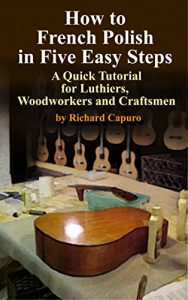Considered the most exquisite of all wood finishes, French polishing is a centuries-old technique using hand-rubbed shellac to produce a deep, high-gloss finish. With over 30 years of experience as a luthier (maker of string instruments) and finisher, the author’s tried and true techniques are presented in this book and will allow the student to quickly master the art of French polishing step by step. The author simplifies the often-confusing and conflicting descriptions of this technique, and presents each step clearly and concisely. The materials needed, the making of the muneca (rubbing pad), the preparation of the shellac solution, the preparation of the wooden surface, the application and maintenance of the finish are all covered.
Technically a type of varnish, shellac is a natural plastic, resinous material made from secretions of the lac insect. Because of this, and because alcohol is the only solvent used, shellac is an environmentally-friendly wood finish, unlike modern finishes such as nitrocellulose lacquer and polyurethane, and is one of the reasons the author embraced this technique many years ago.
In addition to this and to its remarkable beauty as a wood finish, the author also adopted this technique because of the enhanced acoustic properties of a French-polished instrument. The majority of handmade classical guitars today are French polished. Although, as an example, the French polishing of a guitar is described throughout this book, any woodworker applying a finish to any woodworking project can use the techniques presented. French polishing is an essential technique used in antique furniture restoration, and is a value-added specialty skill for any guitar shop to offer. This is also a perfect choice for someone who has just read a How-to-Build-a-Guitar book, finished their first guitar and do not want to additionally purchase a spray booth, spray equipment and safety equipment, not to mention cleaning and the space required.
Technically a type of varnish, shellac is a natural plastic, resinous material made from secretions of the lac insect. Because of this, and because alcohol is the only solvent used, shellac is an environmentally-friendly wood finish, unlike modern finishes such as nitrocellulose lacquer and polyurethane, and is one of the reasons the author embraced this technique many years ago.
In addition to this and to its remarkable beauty as a wood finish, the author also adopted this technique because of the enhanced acoustic properties of a French-polished instrument. The majority of handmade classical guitars today are French polished. Although, as an example, the French polishing of a guitar is described throughout this book, any woodworker applying a finish to any woodworking project can use the techniques presented. French polishing is an essential technique used in antique furniture restoration, and is a value-added specialty skill for any guitar shop to offer. This is also a perfect choice for someone who has just read a How-to-Build-a-Guitar book, finished their first guitar and do not want to additionally purchase a spray booth, spray equipment and safety equipment, not to mention cleaning and the space required.






